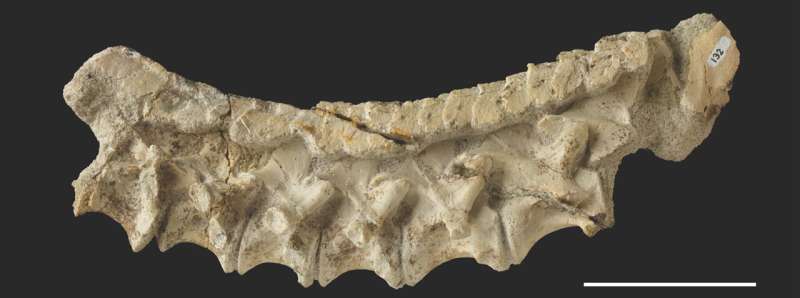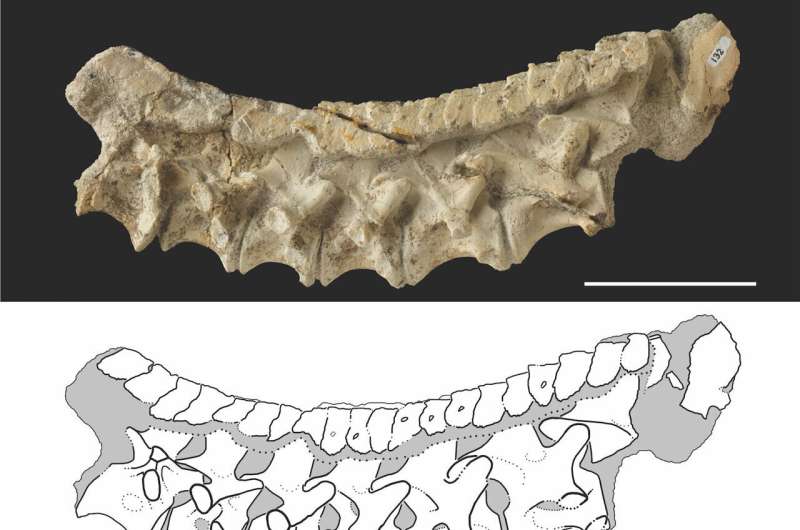This article has been reviewed according to Science X's editorial process and policies. Editors have highlighted the following attributes while ensuring the content's credibility:
fact-checked
peer-reviewed publication
trusted source
proofread
New archosaur species shows that precursor of dinosaurs and pterosaurs was armored

Researchers have described a new species of armored reptile that lived near the time of the first appearance of dinosaurs. With bony plates on its backbone, this archosaur fossil reveals that armor was a boomerang trait in the story of dinosaur and pterosaur evolution: the group's ancestors were armored, but this characteristic was lost and then independently re-evolved multiple times later among specialized dinosaurs like ankylosaurs, stegosaurs, and others. The study is published today in the Zoological Journal of the Linnean Society.
"We are just starting to understand that there were many dinosaur-like creatures across the planet well before dinosaurs evolved," said the study's lead author Sterling Nesbitt, associate professor of geosciences at Virginia Tech and a research associate in the American Museum of Natural History's Division of Paleontology. "Dinosaurs were latecomers to the Triassic reptile party. They showed up well after many dinosaur-looking reptiles were established across our planet."
Archosaurs are reptiles that are divided into two major branches: the bird-line, which includes pterosaurs and dinosaurs, including living dinosaurs (birds); and the crocodilian line, including crocodiles, alligators, caimans, and gharials. The newly described archosaur species, named Mambachiton fiandohana, is the earliest diverging member of the bird line of archosaur evolution.

The fossil, which is about 235 million years old, was found in 1997 in Madagascar by a team of researchers led by the Museum's Frick Curator of Fossil Mammals John Flynn, who worked at the Field Museum at the time, in close collaboration with scientists and students at the University of Antananarivo in Madagascar.
"This discovery documents the importance of the southern hemisphere fossil record in understanding this important period of the Triassic, when dinosaurs were first appearing," Flynn said. "This time interval is really poorly known elsewhere in the world, showing the tremendous value of our quarter-century-long Madagascar-U.S. research and education partnership to advancing scientific knowledge."
A four-legged, long-tailed precursor to dinosaurs and pterosaurs, Mambachiton is estimated to have been 4–6 feet (1.5–2 meters) long, weighing between 25–45 pounds (10–20 kilograms). Unexpectedly, the species had an extensive series of bony plates called osteoderms covering its backbone. Although osteoderms are common in crocodilians and their relatives, they are rare in bird-line archosaurs, with the exception of dinosaurs like stegosaurs, ankylosaurs, titanosaur sauropods, and at least one theropod.
Mambachiton shows definitively that the bird-line archosaur group was ancestrally armored. This armor was lost in the evolution of dinosaurs and pterosaurs but then re-appeared later several times, independently, in the dinosaur lineage.

"The loss and re-evolution of armor is an important aspect of the story of dinosaur evolution—freeing them from some of the biomechanical body constraints of the ancestral archosaurs and potentially contributing to some of the locomotor shifts as dinosaurs diversified into a dizzying array of different ecology and body forms," said co-author Christian Kammerer, a former Gerstner Scholar at the Museum and a research curator in paleontology at the North Carolina Museum of Natural Sciences.
"Mambachiton demonstrates that retention of ancestral features or acquisition of new traits depend on interactions within the ecosystem," said project co-leader Lovasoa Ranivoharimanana of the University of Antananarivo. "When a character is essential, it is retained, but when it is no longer useful, it disappears."
More information: Sterling J Nesbitt et al, The earliest-diverging avemetatarsalian: a new osteoderm-bearing taxon from the Triassic (?Earliest Late Triassic) of Madagascar and the composition of avemetatarsalian assemblages prior to the radiation of dinosaurs, Zoological Journal of the Linnean Society (2023). DOI: 10.1093/zoolinnean/zlad038
Journal information: Zoological Journal of the Linnean Society
Provided by American Museum of Natural History





















